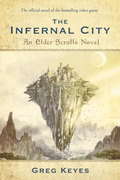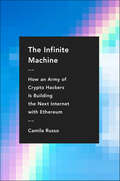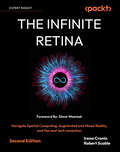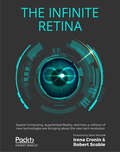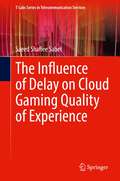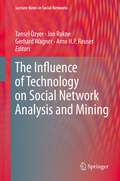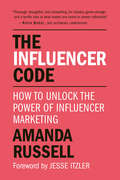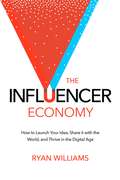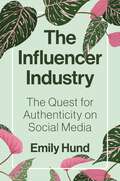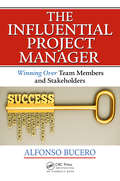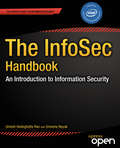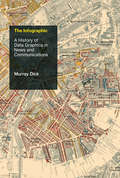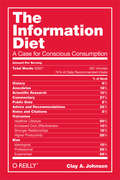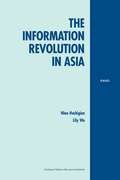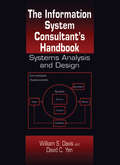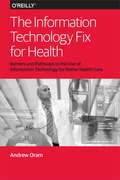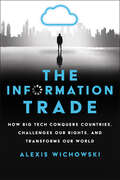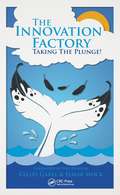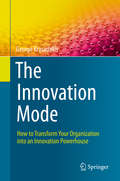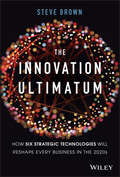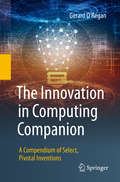- Table View
- List View
The Industrial Information Technology Handbook (Industrial Electronics)
by Richard ZurawskiThe Industrial Information Technology Handbook focuses on existing and emerging industrial applications of IT, and on evolving trends that are driven by the needs of companies and by industry-led consortia and organizations. Emphasizing fast growing areas that have major impacts on industrial automation and enterprise integration, the Handbook covers topics such as industrial communication technology, sensors, and embedded systems.The book is organized into two parts. Part 1 presents material covering new and quickly evolving aspects of IT. Part 2 introduces cutting-edge areas of industrial IT. The Handbook presents material in the form of tutorials, surveys, and technology overviews, combining fundamentals and advanced issues, with articles grouped into sections for a cohesive and comprehensive presentation. The text contains 112 contributed reports by industry experts from government, companies at the forefront of development, and some of the most renowned academic and research institutions worldwide. Several of the reports on recent developments, actual deployments, and trends cover subject matter presented to the public for the first time.
The Infernal City: An Elder Scrolls Novel
by Greg KeyesFour decades after the Oblivion Crisis, Tamriel is threatened anew by an ancient and all-consuming evil. It is Umbriel, a floating city that casts a terrifying shadow-for wherever it falls, people die and rise again. And it is in Umbriel's shadow that a great adventure begins, and a group of unlikely heroes meet. A legendary prince with a secret. A spy on the trail of a vast conspiracy. A mage obsessed with his desire for revenge. And Annaig, a young girl in whose hands the fate of Tamriel may rest . . . .Based on the award-winning The Elder Scrolls, The Infernal City is the first of two exhilarating novels following events that continue the story from The Elder Scrolls IV: Oblivion, named 2006 Game of the Year.From the Trade Paperback edition.
The Infinite Machine: How an Army of Crypto-Hackers Is Building the Next Internet with Ethereum
by Camila RussoWritten with the verve of such works as The Big Short, The History of the Future, and The Spider Network, here is the fascinating, true story of the rise of Ethereum, the second-biggest digital asset in the world, the growth of cryptocurrency, and the future of the internet as we know it.Everyone has heard of Bitcoin, but few know about the second largest cryptocurrency, Ethereum, which has been heralded as the "next internet."The story of Ethereum begins with Vitalik Buterin, a supremely gifted nineteen-year-old autodidact who saw the promise of blockchain when the technology was in its earliest stages. He convinced a crack group of coders to join him in his quest to make a super-charged, global computer.The Infinite Machine introduces Vitalik’s ingenious idea and unfolds Ethereum’s chaotic beginnings. It then explores the brilliant innovation and reckless greed the platform—an infinitely adaptable foundation for experimentation and new applications—has unleashed and the consequences that resulted as the frenzy surrounding it grew: increased regulatory scrutiny, incipient Wall Street interest, and the founding team’s effort to get the Ethereum platform to scale so it can eventually be accessible to the masses.Financial journalist and cryptocurrency expert Camila Russo details the wild and often hapless adventures of a team of hippy-anarchists, reluctantly led by an ambivalent visionary, and lays out how this new foundation for the internet will spur both transformation and fraud—turning some into millionaires and others into felons—and revolutionize our ideas about money.
The Infinite Retina: Navigate Spatial Computing, Augmented and Mixed Reality, and the next tech revolution
by Irena Cronin Robert ScobleAn insightful look into how spatial computing is transforming seven major industries today—from healthcare to retail and finance—and what it means for businesses and consumers This second edition explores the impact of generative AI, Apple Vision Pro, and Meta Quest, while offering a critical perspective on challenges like data privacy, automation, and ethical concernsKey FeaturesExplore spatial computing's shift from theory to real-world use by Apple, Meta, and TeslaExamine spatial computing disruptions across seven industries with expert insights on real-world applicationsAnalyze generative AI and Apple Vision Pro's impact on retail, healthcare, and financePurchase of the print or Kindle book includes a free PDF eBookBook DescriptionWhat is Spatial Computing, and why are companies like Tesla, Apple, and Meta investing billions into it? In The Infinite Retina, Irena Cronin and Robert Scoble explore how spatial computing—where humans and machines interact in a digital–physical space—has progressed beyond theory into real-world applications. This second edition has many substantial updates, including two new chapters on the relevance of Generative AI in Spatial Computing and a new chapter on the impact of Apple Vision Pro. Each existing chapter has been updated to have the most current information and commentary. The book offers a fresh look at seven major industries, including healthcare and retail, featuring updated case studies, expert commentary, and real-world examples. Additionally, it addresses crucial risks and challenges, such as data privacy, automation's impact on employment, and ethical concerns. This edition moves beyond speculation to critically analyze what Spatial Computing means for businesses and individuals today.What you will learnExplore how spatial computing is applied today, with examples from Apple, Meta, Tesla, and other major playersAnalyze the economic and ethical challenges of spatial computing, including automation and privacyUnderstand generative AI's influence on spatial computing, from creativity to automationInvestigate industry-specific case studies, from autonomous vehicles to retail and financeGain expert insights into industry trends, including potential career paths in the spatial computing revolutionDiscover how virtual reality and augmented reality will change healthcareWho this book is forThe Infinite Retina is for anyone interested in the future of technology and how augmented reality and spatial computing (among other developments) will affect both businesses and the individual.
The Infinite Retina: Spatial Computing, Augmented Reality, and how a collision of new technologies are bringing about the next tech revolution
by Irena Cronin Robert Scoble Steve WozniakA compelling and insightful look at the future of Spatial Computing, and how this cutting-edge technology is changing the way we do business across seven primary industries, and what it means for humanity as a whole. Key Features Discover how Spatial Computing is changing the face of technology Get a roadmap for the disruptions caused by Spatial Computing and how it will affect seven major industries Gain insights about the past, present, and future of technology from the world's leading experts and innovators Book Description What is Spatial Computing and why is everyone from Tesla, Apple, and Facebook investing heavily in it? In The Infinite Retina, authors Irena Cronin and Robert Scoble attempt to answer that question by helping you understand where Spatial Computing?an augmented reality where humans and machines can interact in a physical space?came from, where it's going, and why it's so fundamentally different from the computers or mobile phones that came before. They present seven visions of the future and the industry verticals in which Spatial Computing has the most influence?Transportation; Technology, Media, and Telecommunications; Manufacturing; Retail; Healthcare; Finance; and Education. The book also shares insights about the past, present, and future from leading experts an other industry veterans and innovators, including Sebastian Thrun, Ken Bretschneider, and Hugo Swart. They dive into what they think will happen in Spatial Computing in the near and medium term, and also explore what it could mean for humanity in the long term. The Infinite Retina then leaves it up to you to decide whether Spatial Computing is truly where the future of technology is heading or whether it's just an exciting, but passing, phase. What you will learn Look back at historical paradigms that changed the face of technology Consider how Spatial Computing could be the new technology that changes our lives See how Virtual and Augmented Reality will change the way we do healthcare Learn how Spatial Computing technology will lead to fully automated transportation Think about how Spatial Computing will change the manufacturing industry Explore how finance and retail are going to be impacted through Spatial Computing devices Hear accounts from industry experts on what they expect Spatial Computing to bring to their sectors Who this book is for The Infinite Retina is for anyone interested in the future of technology and how Augmented Reality and Spatial Computing (among other developments) will affect both businesses and the individual.
The Influence of Delay on Cloud Gaming Quality of Experience (T-Labs Series in Telecommunication Services)
by Saeed Shafiee SabetThis book provides an understanding of the impact of delay on cloud gaming Quality of Experience (QoE) and proposes techniques to compensate for this impact, leading to a better gaming experience when there are network delays. The author studies why some games in the cloud are more delay sensitive than others by identifying game characteristics influencing a user's delay perception and predicting the gaming QoE degraded by the delay. The author also investigates the impact of jitter and serial-position effects on gaming QoE and delay. Using the insight gained, the author presents delay compensation techniques that can mitigate the negative influence of delay on gaming QoE that use the game characteristics to adapt the games.
The Influence of Technology on Social Network Analysis and Mining
by Gerhard Wagner Jon Rokne Tansel Özyer Arno H.P. ReuserThe study of social networks was originated in social and business communities. In recent years, social network research has advanced significantly; the development of sophisticated techniques for Social Network Analysis and Mining (SNAM) has been highly influenced by the online social Web sites, email logs, phone logs and instant messaging systems, which are widely analyzed using graph theory and machine learning techniques. People perceive the Web increasingly as a social medium that fosters interaction among people, sharing of experiences and knowledge, group activities, community formation and evolution. This has led to a rising prominence of SNAM in academia, politics, homeland security and business. This follows the pattern of known entities of our society that have evolved into networks in which actors are increasingly dependent on their structural embedding General areas of interest to the book include information science and mathematics, communication studies, business and organizational studies, sociology, psychology, anthropology, applied linguistics, biology and medicine.
The Influencer Code: How to Unlock the Power of Influencer Marketing
by Amanda RussellThe Influencer Code is the essential reference for any company looking to leverage the power of influencers to elevate their brand and grow their business.From Fortune 500s to local fitness studios, whether you offer financial services or sell donuts, reaching today's consumers is more complicated than ever. More and more, marketers are reaching out to people who style themselves "influencers": those people who have a big—and, more importantly—loyal audience ready to hear what they have to say about anything.Yet despite "influencer marketing" fast becoming one of the biggest buzz terms of the decade, it couldn't be more misunderstood.Written by an accomplished entrepreneur, professor, and award-winning YouTube star, The Influencer Code breaks down the biggest myths that brands are getting wrong and shows you how to get it right by defining and showcasing what true influencer marketing is and how to leverage it to achieve your business goals in a simple yet powerful 3-step code.The Influencer Code simplifies the complex world of influencer marketing, covering how to research, evaluate, and employ the right influencers for their markets, as well as how to legally and strategically integrate them into marketing campaigns to achieve specific goals.The future of marketing depends on forming authentic partnerships between brands and influencers. The go-to resource for all things influencer marketing, The Influencer Code is your shortcut to making that future a reality.
The Influencer Economy: How to Launch Your Idea, Share It with the World, and Thrive in the Digital Age
by Ryan Williams<p>Reinvent yourself and grow radical influence. <p>What if you got heard, and became visible in a seemingly noisy online world from day #1 of your new idea? Imagine yourself having a worldwide influence in your industry, profession, or life. What if you could grow universal influence and drive winning collaborations? <p>Ryan Williams is a former standup comedian, author, and podcast host, who for the last three years, on Stories From The Influencer Economy podcast, he interviewed over 100 influencers who have built ideas online such as: Seth Godin, Brad Feld, Derek Sivers, Troy Carter, Jemele Hill, Kevin Kelly and many others. In "The Influencer Economy" he explains how influence is a learned and acquired skill and how your influence can be honed and crafted over time. Williams answers the question: what are the secrets to grow your influence?</p>
The Influencer Industry: The Quest for Authenticity on Social Media
by Emily HundA critical history of the social media influencer&’s rise to global prominenceBefore there were Instagram likes, Twitter hashtags, or TikTok trends, there were bloggers who seemed to have the passion and authenticity that traditional media lacked. The Influencer Industry tells the story of how early digital creators scrambling for work amid the Great Recession gave rise to the multibillion-dollar industry that has fundamentally reshaped culture, the flow of information, and how we relate to ourselves and each other.Drawing on dozens of in-depth interviews with leading social media influencers, brand executives, marketers, talent managers, trend forecasters, and others, Emily Hund shows how early industry participants focused on creating and monetizing digital personal brands as a means of exerting control over their professional destinies in a time of acute economic uncertainty. Over time, their activities coalesced into an industry whose impact has reached far beyond the dreams of its progenitors—and beyond their control. Hund illustrates how the methods they developed for creating, monetizing, and marketing social media content have permeated our lives and untangles the unforeseen cultural and economic costs.The Influencer Industry reveals how, in an increasingly fractured and profit-driven communications environment, the people we think of as &“real&” are merely those who have learned to exploit the industry&’s ever-shifting constructions of authenticity.
The Influential Project Manager: Winning Over Team Members and Stakeholders (Best Practices in Portfolio, Program, and Project Management)
by Alfonso Bucero MSc PMP PMI-RMP PMI FAll best practice recommendations and key success criteria point to the importance of developing soft skills as a project manager, but few sources exist about how to develop the power of influence for achieving better project and business results. Filling this need, this book supplies readers with guidance on how to improve their influence skills to achieve better business results. It explains how to set and meet ambitious goals for you, your team, and your stakeholders. It describes how to listen actively to influence people and how to build partnerships that can pay dividends for a lifetime.
The InfoSec Handbook: An Introduction to Information Security
by Umesh Hodeghatta Rao Umesha NayakThe InfoSec Handbook offers the reader an organized layout of information that is easily read and understood. Allowing beginners to enter the field and understand the key concepts and ideas, while still keeping the experienced readers updated on topics and concepts. It is intended mainly for beginners to the field of information security, written in a way that makes it easy for them to understand the detailed content of the book. The book offers a practical and simple view of the security practices while still offering somewhat technical and detailed information relating to security. It helps the reader build a strong foundation of information, allowing them to move forward from the book with a larger knowledge base. Security is a constantly growing concern that everyone must deal with. Whether it's an average computer user or a highly skilled computer user, they are always confronted with different security risks. These risks range in danger and should always be dealt with accordingly. Unfortunately, not everyone is aware of the dangers or how to prevent them and this is where most of the issues arise in information technology (IT). When computer users do not take security into account many issues can arise from that like system compromises or loss of data and information. This is an obvious issue that is present with all computer users. This book is intended to educate the average and experienced user of what kinds of different security practices and standards exist. It will also cover how to manage security software and updates in order to be as protected as possible from all of the threats that they face. What you'll learn Essentials of information security in all forms Importance of information security in present day business Establishing an ISMS through a step by step process Best practices in implementation The various domains of information security Who this book is for Beginners to experts in information security Table of Contents 1: Introduction to Security2: History of Computer Security3: Key Concepts and Principles4: Access Controls5: Information Systems Management6: Application and Web Security7: Malicious Software and Anti-Virus Software8: Cryptography9: Understanding Networks10: Firewalls11: Intrusion Detection and Prevention Systems12: Virtual Private Networks13: Data Backups & Cloud Computing14: Physical Security and Biometrics15: Social Engineering16. Current Trends in Information Security17. Bibliography"
The Infographic: A History of Data Graphics in News and Communications (History and Foundations of Information Science)
by Murray DickAn exploration of infographics and data visualization as a cultural phenomenon, from eighteenth-century print culture to today's data journalism.Infographics and data visualization are ubiquitous in our everyday media diet, particularly in news—in print newspapers, on television news, and online. It has been argued that infographics are changing what it means to be literate in the twenty-first century—and even that they harmonize uniquely with human cognition. In this first serious exploration of the subject, Murray Dick traces the cultural evolution of the infographic, examining its use in news—and resistance to its use—from eighteenth-century print culture to today's data journalism. He identifies six historical phases of infographics in popular culture: the proto-infographic, the classical, the improving, the commercial, the ideological, and the professional.Dick describes the emergence of infographic forms within a wider history of journalism, culture, and communications, focusing his analysis on the UK. He considers their use in the partisan British journalism of late eighteenth and early nineteenth-century print media; their later deployment as a vehicle for reform and improvement; their mass-market debut in the twentieth century as a means of explanation (and sometimes propaganda); and their use for both ideological and professional purposes in the post–World War II marketized newspaper culture. Finally, he proposes best practices for news infographics and defends infographics and data visualization against a range of criticism. Dick offers not only a history of how the public has experienced and understood the infographic, but also an account of what data visualization can tell us about the past.
The Information Diet
by Clay A. JohnsonThe modern human animal spends upwards of 11 hours out of every 24 in a state of constant consumption. Not eating, but gorging on information ceaselessly spewed from the screens and speakers we hold dear. Just as we have grown morbidly obese on sugar, fat, and flour--so, too, have we become gluttons for texts, instant messages, emails, RSS feeds, downloads, videos, status updates, and tweets. We're all battling a storm of distractions, buffeted with notifications and tempted by tasty tidbits of information. And just as too much junk food can lead to obesity, too much junk information can lead to cluelessness. The Information Diet shows you how to thrive in this information glut--what to look for, what to avoid, and how to be selective. In the process, author Clay Johnson explains the role information has played throughout history, and why following his prescribed diet is essential for everyone who strives to be smart, productive, and sane. In The Information Diet, you will: Discover why eminent scholars are worried about our state of attention and general intelligence Examine how today's media--Big Info--give us exactly what we want: content that confirms our beliefs Learn to take steps to develop data literacy, attention fitness, and a healthy sense of humor Become engaged in the economics of information by learning how to reward good information providers Just like a normal, healthy food diet, The Information Diet is not about consuming less--it's about finding a healthy balance that works for you
The Information Diet: A Case for Conscious Comsumption
by Clay A. JohnsonThis is a softcover version of the title released in 2011; there is no new material.The modern human animal spends upwards of 11 hours out of every 24 in a state of constant consumption. Not eating, but gorging on information ceaselessly spewed from the screens and speakers we hold dear. Just as we have grown morbidly obese on sugar, fat, and flour—so, too, have we become gluttons for texts, instant messages, emails, RSS feeds, downloads, videos, status updates, and tweets.We're all battling a storm of distractions, buffeted with notifications and tempted by tasty tidbits of information. And just as too much junk food can lead to obesity, too much junk information can lead to cluelessness. The Information Diet shows you how to thrive in this information glut—what to look for, what to avoid, and how to be selective. In the process, author Clay Johnson explains the role information has played throughout history, and why following his prescribed diet is essential for everyone who strives to be smart, productive, and sane.In The Information Diet, you will:Discover why eminent scholars are worried about our state of attention and general intelligenceExamine how today’s media—Big Info—give us exactly what we want: content that confirms our beliefsLearn to take steps to develop data literacy, attention fitness, and a healthy sense of humorBecome engaged in the economics of information by learning how to reward good information providersJust like a normal, healthy food diet, The Information Diet is not about consuming less—it’s about finding a healthy balance that works for you
The Information Revolution in Asia
by Nina Hachigian Lily WuThis report discusses the information revolution in the Asia-Pacific region and its likely course over the next five to ten years. Key questions addressed in this report include the extent to which the information revolution has taken hold of markets in this region, the political implications of the information revolution for Asian governments, the variations between individual countries, and the prospects for further information-technology-related developments in the region.
The Information System Consultant's Handbook: Systems Analysis and Design
by William S. Davis David C. YenThe Information System Consultant's Handbook familiarizes systems analysts, systems designers, and information systems consultants with underlying principles, specific documentation, and methodologies.Corresponding to the primary stages in the systems development life cycle, the book divides into eight sections:PrinciplesInformation Gathering and Problem DefinitionProject Planning and Project ManagementSystems AnalysisIdentifying AlternativesComponent DesignTesting and ImplementationOperation and MaintenanceEighty-two chapters comprise the book, and each chapter covers a single tool, technique, set of principles, or methodology. The clear, concise narrative, supplemented with numerous illustrations and diagrams, makes the material accessible for readers - effectively outlining new and unfamiliar analysis and design topics.
The Information Technology Fix for Health
by Andy OramNew information technologies (IT) hold the promise of better health in a world increasingly coping with chronic illness. The miniaturization of ever-more powerful sensing devices, along with the collection, analysis, and sharing of data, support activities in homes and clinics that let patients have a greater role in their own health care.This article takes you on a tour of specific technologies, tools, and trends to help you understand what’s been accomplished, what’s feasible in the near future, and why some technologies seem to languish despite their apparent advantages. You’ll also discover how these groundbreaking approaches can help lower the enormous health care costs in the US.Learn how devices and sensors are transforming medical equipment and helping self-monitoring go mainstreamUnderstand how data is gathered, stored, and analyzed, as well as the role shared data plays in clinical researchExplore the way IT helps medical teams coordinate, and how "telehealth" enables better patient treatment at homeLearn how health IT helps empower patients by providing more transparency in the systemExamine the standards in data storage and electronic health records, and weaknesses that need to be addressed in current systems
The Information Trade: How Big Tech Conquers Countries, Challenges Our Rights, and Transforms Our World
by Alexis Wichowski"A timely, compelling, and expertly researched passport to the tech companies that rule today's digital landscape."—Blake Harris, bestselling author of Console Wars and The History of the Future.In this provocative book about our new tech-based reality, political insider and tech expert Alexis Wichowski considers the unchecked rise of tech giants like Facebook, Google, Amazon, Apple, Microsoft, and Tesla—what she calls “net states”— and their unavoidable influence in our lives. Rivaling nation states in power and capital, today’s net states are reaching into our physical world, inserting digital services into our lived environments in ways both unseen and, at times, unknown to us. They are transforming the way the world works, putting our rights up for grabs, from personal privacy to national security. Combining original reporting and insights drawn from more than 100 interviews with technology and government insiders, including Microsoft president Brad Smith, Google CEO Eric Schmidt, the former Federal Trade Commission chair under President Obama, and the managing director of Jigsaw—Google’s Department of Counter-terrorism against extremism and cyber-attacks—The Information Trade explores what happens we give up our personal freedom and individual autonomy in exchange for an easy, plugged-in existence, and shows what we can do to control our relationship with net states before they irreversibly change our future.
The Inmates are Running the Asylum
by Alan CooperImagine, at a terrifyingly aggressive rate, everything you regularly use is being equipped with computer technology. Think about your phone, cameras, cars-everything-being automated and programmed by people who in their rush to accept the many benefits of the silicon chip, have abdicated their responsibility to make these products easy to use. The Inmates Are Running the Asylum argues that the business executives who make the decisions to develop these products are not the ones in control of the technology used to create them. Insightful and entertaining, The Inmates Are Running the Asylum uses the author's experiences in corporate America to illustrate how talented people continuously design bad software-based products and why we need technology to work the way average people think. Somewhere out there is a happy medium that makes these types of products both user and bottom-line friendly; this book discusses why we need to quickly find that medium.
The Inner Workings of Life
by Eberhard O. VoitLiving systems are dynamic and extremely complex and their behaviour is often hard to predict by studying their individual parts. Systems biology promises to reveal and analyse these highly connected, regulated and adaptable systems, using mathematical modelling and computational analysis. This new systems approach is already having a broad impact on biological research and has potentially far-reaching implications for our understanding of life. Written in an informal and non-technical style, this book provides an accessible introduction to systems biology. Self-contained vignettes each convey a key theme and are intended to enlighten, provoke and interest readers of different academic disciplines, but also to offer new insight to those working in the field. Using a minimum amount of jargon and no mathematics, Voit manages to convey complex ideas and give the reader a genuine sense of the excitement that systems biology brings with it, as well as the current challenges and opportunities.
The Innovation Factory
by Gilles Garel Elmar MockThe Innovation Factory takes a fresh look at the fine art of breakthrough innovation. What makes it unique is that it brings together an experienced scholar and a serial entrepreneur who share the same passion for understanding the processes and theories needed to innovate over and over again. The book marries theory with practical examples focusin
The Innovation Mode: How to Transform Your Organization into an Innovation Powerhouse
by George KrasadakisThis book presents unique insights and advice on defining and managing the innovation transformation journey. Using novel ideas, examples and best practices, it empowers management executives at all levels to drive cultural, technological and organizational changes toward innovation. Covering modern innovation techniques, tools, programs and strategies, it focuses on the role of the latest technologies (e.g., artificial intelligence to discover, handle and manage ideas), methodologies (including Agile Engineering and Rapid Prototyping) and combinations of these (like hackathons or gamification). At the same time, it highlights the importance of culture and provides suggestions on how to build it. In the era of AI and the unprecedented pace of technology evolution, companies need to become truly innovative in order to survive. The transformation toward an innovation-led company is difficult – it requires a strong leadership and culture, advanced technologies and well-designed programs. The book is based on the author’s long-term experience and novel ideas, and reflects two decades of startup, consulting and corporate leadership experience. It is intended for business, technology, and innovation leaders.
The Innovation Ultimatum: How six strategic technologies will reshape every business in the 2020s
by Steve BrownPrepares leaders for the 2020s—an accessible guide to the key technologies that will reshape business in the coming decade Most businesses identify six key digital technologies—artificial intelligence (AI), distributed ledgers and blockchain, the Internet of Things (IoT), autonomous machines, virtual and augmented reality, and 5G communication—as critical to their relevance and growth over the coming ten years. These new disruptive technologies present significant opportunity for businesses in every industry. The first businesses to understand automation and these transformative technologies will be the ones to reap the greatest rewards in the marketplace. The Innovation Ultimatum helps leaders understand the key technologies poised to reshape business in the next decade and prepare their organizations for technology-enabled change. Using straightforward, jargon-free language, this important resource provides a set of strategic questions every leader will need to ask and answer in order to prepare for the impending changes to the business landscape. Author Steve Brown shares his insights to help leaders take full advantage of the next wave of digital transformation and describes compelling examples of how businesses are already embracing new technologies to optimize operations, create new value, and serve customers in new ways. Written for anyone that wants to understand how automation and new technology will fundamentally restructure business, this book enables readers to: Understand the implications of technology-driven change across industrial sectors Apply important insights to their own business Gain competitive advantage by implementing new technologies Prepare for the future of work and understand the skills needed to thrive in a post-automation economy Adopt critical digital technologies in any organization Providing invaluable cutting-edge content, The Innovation Ultimatum is a much-needed source of guidance and inspiration for business leaders, board members, C-suite executives, and senior managers who need to prepare their businesses for the future.
The Innovation in Computing Companion: A Compendium of Select, Pivotal Inventions
by Gerard O’ReganThis encyclopedic reference provides a concise and engaging overview of the groundbreaking inventions and conceptual innovations that have shaped the field of computing, and the technology that runs the modern world. Each alphabetically-ordered entry presents a brief account of a pivotal innovation and the great minds behind it, selected from a wide range of diverse topics.Topics and features:Describes the development of Babbage’s computing machines, Leibniz’s binary arithmetic, Boole’s symbolic logic, and Von Neumann architectureReviews a range of historical analog and digital computers, significant mainframes and minicomputers, and pioneering home and personal computersDiscusses a selection of programming languages and operating systems, along with key concepts in software engineering and commercial computingExamines the invention of the transistor, the integrated circuit, and the microprocessorRelates the history of such developments in personal computing as the mouse, the GUI, Atari video games, and Microsoft OfficeSurveys innovations in communications, covering mobile phones, WiFi, the Internet and World Wide Web, e-commerce, smartphones, social media, and GPSPresents coverage of topics on artificial intelligence, the ATM, digital photography and digital music, robotics, and WikipediaContains self-test quizzes and a helpful glossaryThis enjoyable compendium will appeal to the general reader curious about the intellectual milestones that led to the digital age, as well as to the student of computer science seeking a primer on the history of their field.Dr. Gerard O'Regan is a CMMI software process improvement consultant with research interests including software quality and software process improvement, mathematical approaches to software quality, and the history of computing. He is the author of such Springer titles as World of Computing, Concise Guide to Formal Methods, Concise Guide to Software Engineering, and Guide to Discrete Mathematics.

